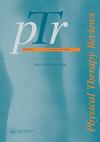舞蹈作为成人和老年神经疾病患者康复工具的应用范围系统综述
IF 1.2
Q4 REHABILITATION
引用次数: 0
摘要
【摘要】目的在康复过程中实施舞蹈,可以激发患者的积极性,提高患者的参与度。舞蹈风格、神经系统疾病类型、功能概况和结果的汇编有助于理解舞蹈在神经功能康复方案中的应用。因此,本文对舞蹈在神经康复中的研究进行综述。材料和方法基于乔安娜布里格斯研究所的方法,这篇综述论述了舞蹈在各种院内和院外康复环境中的作用。检索于2021年12月至2022年7月期间在MEDLINE/PubMed®、Cochrane Library、PEDro、Scopus、CINAHL、Web of Science、Science Direct和Springer上进行,对研究进行了三步分析和分类:预分析、材料探索和数据处理。结果在总共2256项研究中,有62项被纳入。过去二十年的出版物数量为:1980-1989年(n = 2项研究);1990-1999年(n = 1);2000-2009年(n = 4);2010-2019年(n = 41)和2020年(n = 16)。与年轻个体(n = 20)和男性个体(n = 589)相比,舞蹈者在老年人(n = 42)和女性个体(n = 599)中占主导地位。包括交际舞(n = 24)、阿根廷探戈(n = 20)、有氧舞(n = 9)和芭蕾舞(n = 8)。主要的神经系统疾病是帕金森病(n = 40)、中风(n = 7)、智力残疾(n = 4)、多发性硬化症(n = 4)、痴呆或认知障碍(n = 3)。主要的结果是平衡和步态分析、认知功能、运动协调、心理症状和生活质量。结论舞蹈在神经康复中的应用在过去的二十年中有所增加,重点是交际舞,阿根廷探戈和古典芭蕾在帕金森病(PD)中的应用。致谢致谢致谢致谢致谢致谢致谢致谢致谢致谢致谢致谢致谢致谢致谢致谢致谢致谢致谢致谢致谢致谢致谢作者声明,本研究是在没有任何可能被解释为潜在利益冲突的商业或财务关系的情况下进行的。数据可用性声明当前研究期间生成和/或分析的数据集可根据通讯作者的合理要求提供。其他信息资金作者报告没有与本文所述工作相关的资金。本文章由计算机程序翻译,如有差异,请以英文原文为准。
A scoping systematic review of dance application as a rehabilitation tool in adults and older individuals with neurological diseases
AbstractPurpose The implementation of dance during rehabilitation can generate motivation and patient engagement. The compilation about dance style, type of neurological disease, functional profile, and outcomes may facilitate the understanding of dance applications in neurofunctional rehabilitation scenario. Therefore, this review mapped the studies on dance in neurological rehabilitation.Materials and methods Based on Joanna Briggs Institute methodology, this scoping review addressed dance in rehabilitation in various in- and out-of-hospital environments. The search was conducted between December 2021 and July 2022 on MEDLINE/PubMed®, Cochrane Library, PEDro, Scopus, CINAHL, Web of Science, Science Direct, and Springer, with a three-step analysis and categorization of the studies: pre-analysis, exploration of the material, and data processing.Results On a total of 2,256 studies identified, 62 were included. The number of publications in the last two decades were: 1980–1989 (n = 2 studies); 1990–1999 (n = 1); 2000–2009 (n = 4); 2010–2019 (n = 41), and from 2020 (n = 16). Dancers were predominant in older (n = 42) and female (n = 599) individuals, compared to younger (n = 20) and male (n = 589) individuals, respectively. They included ballroom dancing (n = 24), Argentine or Adapted Tango (n = 20), aerobic dance (n = 9), and ballet (n = 8). The predominant neurological conditions were Parkinson’s disease (n = 40), stroke (n = 7), intellectual disability (n = 4), multiple sclerosis (n = 4), dementia or cognitive disabilities (n = 3). The predominant outcomes were balance and gait analysis, cognitive functions, motor coordination, psychological symptoms, and quality of life.Conclusion The application of dance in neurological rehabilitation has increased over the last two decades, with an emphasis on ballroom dancing, Argentine tango, and classical ballet in Parkinson’s disease (PD).Keywords: Dancerehabilitationneurological diseasesscoping reviewfunctionality AcknowledgmentsNo specific funding was received from any bodies in the public, commercial or not-for-profit sectors to carry out the work described in this article.Disclosure statementThe authors declare that the research was conducted in the absence of any commercial or financial relationships that could be construed as a potential conflict of interest.Data availability statementThe datasets generated during and/or analyzed during the current study are available from the corresponding author on reasonable request.Additional informationFundingThe author(s) reported there is no funding associated with the work featured in this article.
求助全文
通过发布文献求助,成功后即可免费获取论文全文。
去求助
来源期刊

Physical Therapy Reviews
REHABILITATION-
CiteScore
1.30
自引率
0.00%
发文量
26
期刊介绍:
Physical Therapy Reviews is an international journal which aims to publish contemporary reviews, discussion papers and editorials within physical therapy, and in those basic and clinical sciences which are the basis of physical therapy. The journal is aimed at all those involved in research, teaching and practice within the area of physical therapy. Reviews (both descriptive and systematic) are invited in the following areas, which reflect the breadth and diversity of practice within physical therapy: •neurological rehabilitation •movement and exercise •orthopaedics and rheumatology •manual therapy and massage •sports medicine •measurement •chest physiotherapy •electrotherapeutics •obstetrics and gynaecology •complementary therapies •professional issues •musculoskeletal rehabilitation
 求助内容:
求助内容: 应助结果提醒方式:
应助结果提醒方式:


